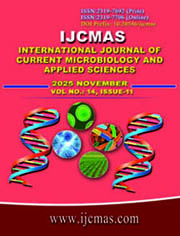


 National Academy of Agricultural Sciences (NAAS)
National Academy of Agricultural Sciences (NAAS)

|
PRINT ISSN : 2319-7692
Online ISSN : 2319-7706 Issues : 12 per year Publisher : Excellent Publishers Email : editorijcmas@gmail.com / submit@ijcmas.com Editor-in-chief: Dr.M.Prakash Index Copernicus ICV 2018: 95.39 NAAS RATING 2020: 5.38 |
In the present study ten endophytic bacteria were isolated from Paederia foetida and were subjected to antibacterial activity test. The maximum zone of inhibition was observed by the isolate PFNP2 against Staphylococcus aureus (17.6±0.5 mm) followed by Salmonella sp. (15.3±0.5 mm) and MRSA (14.6±0.5 mm). The bacterial isolate was identified as Staphylococcus haemolyticus by 16s rRNA gene sequencing with NCBI accession number PQ143273. Genes that are essential for the adaptation to the plants were mainly acquired by horizontal gene transfer which could explain the adaptation of such bacteria to plant environment. Presence of aromatic, aliphatic (C-H) and carboxylic acid (C=O) groups were detected in the ethyl acetate extract of the selected isolate by FTIR analysis. Bioactive compounds such as 2- Piperidinone, N- Hexadecanoic acid and Pyrrolo [1,2-a] pyrazine-1,4-dione, hexahydro-3-(phenylmethyl)- identified from the GC-MS mass spectra of the bacterial extract have been reported to have antimicrobial properties. This indicates that bacterial endophytes from Paederia foetida could be a source of antimicrobial compounds for use in biotechnological and pharmaceutical applications.
Alvin, A., Miller, K.I. and Neilan, B.A., 2014. Exploring the potential of endophytes from medicinal plants as sources of antimycobacterial compounds. Microbiological research, 169(7-8), pp.483-495. https://doi.org/10.1016/j.micres.2013.12.009
Chaudhry, V. and Patil, P.B., 2020. Evolutionary insights into adaptation of Staphylococcus haemolyticus to human and non-human niches. Genomics, 112(2), pp.2052-2062. https://doi.org/10.1016/j.ygeno.2019.11.018
Coque, T., Graham, D.W., Pruden, A., So, A. and Topp, E., 2023. Bracing for Superbugs: Strengthening environmental action in the One Health response to antimicrobial resistance. https://doi.org/10.57711/hdq2-xr65
Cotter, P.D., Ross, R.P. and Hill, C., 2013. Bacteriocins—a viable alternative to antibiotics? Nature Reviews Microbiology, 11(2), pp.95-105. https://doi.org/10.1038/nrmicro2937
Ganesan, T., Subban, M., Christopher Leslee, D.B., Kuppannan, S.B. and Seedevi, P., 2024. Structural characterization of n-hexadecanoic acid from the leaves of Ipomoea eriocarpa and its antioxidant and antibacterial activities. Biomass Conversion and Biorefinery, 14(13), pp.14547-14558. https://doi.org/10.1007/s13399-022-03576-w
Kiran, G.S., Priyadharsini, S., Sajayan, A., Ravindran, A. and Selvin, J., 2018. An antibiotic agent pyrrolo [1, 2-a] pyrazine-1, 4-dione, hexahydro isolated from a marine bacteria Bacillus tequilensis MSI45 effectively controls multi-drug resistant Staphylococcus aureus. RSC advances, 8(32), pp.17837-17846. https://doi.org/10.1039/C8RA00820E
Mamillapalli, V., 2020. Antiasthmatic activity of 2-piperidone by selective animal models. Journal of Research in Pharmacy, 24(3), pp.334-340. https://doi.org/10.35333/jrp.2020.155
Roy, P., Das, H., Ali, M.S., Sarkar, P. and Chattopadhyay, S., 2021. A review on Paederia foetida as a medicinal plant and it’s pharmacological activities. World J. Pharm. Pharm. Sci, 10(12), pp.637-647. https://doi.org/10.20959/wjpps202112-20659
Saadouli, I., Zendah El Euch, I., Trabelsi, E., Mosbah, A., Redissi, A., Ferjani, R., Fhoula, I., Cherif, A., Sabatier, J.M., Sewald, N. and Ouzari, H.I., 2020. Isolation, characterization and chemical synthesis of large spectrum antimicrobial cyclic dipeptide (L-leu-L-pro) from Streptomyces misionensis V16R3Y1 bacteria extracts. A novel 1H NMR metabolomic approach. Antibiotics, 9(5), p.270. https://doi.org/10.3390/antibiotics9050270
Simons, A., Alhanout, K. and Duval, R.E., 2020. Bacteriocins, antimicrobial peptides from bacterial origin: overview of their biology and their impact against multidrug-resistant bacteria. Microorganisms, 8(5), p.639. https://doi.org/10.3390/microorganisms8050639
Strobel, G.A., 2003. Endophytes as sources of bioactive products. Microbes and infection, 5(6), pp.535-544. https://doi.org/10.1016/S1286-4579(03)00073-X
Zhang, F. and Cheng, W., 2022. The mechanism of bacterial resistance and potential bacteriostatic strategies. Antibiotics, 11(9), p.1215. https://doi.org/10.3390/antibiotics11091215
 |
 |
 |
 |
 |